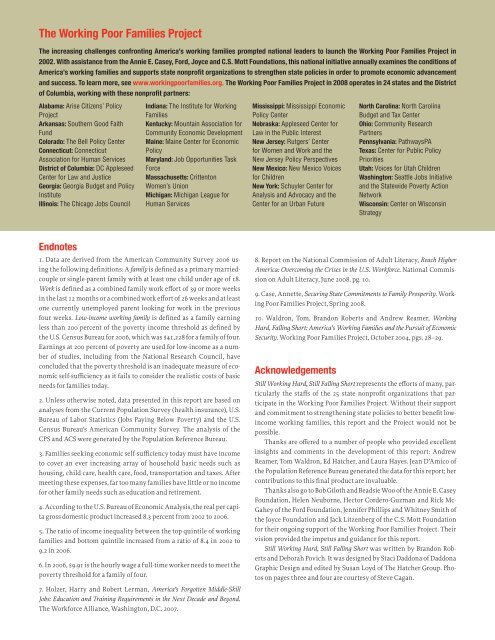Still Working Hard, Still Falling Short - The Working Poor Families ...
Still Working Hard, Still Falling Short - The Working Poor Families ...
Still Working Hard, Still Falling Short - The Working Poor Families ...
Create successful ePaper yourself
Turn your PDF publications into a flip-book with our unique Google optimized e-Paper software.
<strong>The</strong> <strong>Working</strong> <strong>Poor</strong> <strong>Families</strong> Project<strong>The</strong> increasing challenges confronting America’s working families prompted national leaders to launch the <strong>Working</strong> <strong>Poor</strong> <strong>Families</strong> Project in2002. With assistance from the Annie E. Casey, Ford, Joyce and C.S. Mott Foundations, this national initiative annually examines the conditions ofAmerica’s working families and supports state nonprofit organizations to strengthen state policies in order to promote economic advancementand success. To learn more, see www.workingpoorfamilies.org. <strong>The</strong> <strong>Working</strong> <strong>Poor</strong> <strong>Families</strong> Project in 2008 operates in 24 states and the Districtof Columbia, working with these nonprofit partners:Alabama: Arise Citizens’ PolicyProjectArkansas: Southern Good FaithFundColorado: <strong>The</strong> Bell Policy CenterConnecticut: ConnecticutAssociation for Human ServicesDistrict of Columbia: DC AppleseedCenter for Law and JusticeGeorgia: Georgia Budget and PolicyInstituteIllinois: <strong>The</strong> Chicago Jobs CouncilIndiana: <strong>The</strong> Institute for <strong>Working</strong><strong>Families</strong>Kentucky: Mountain Association forCommunity Economic DevelopmentMaine: Maine Center for EconomicPolicyMaryland: Job Opportunities TaskForceMassachusetts: CrittentonWomen’s UnionMichigan: Michigan League forHuman ServicesMississippi: Mississippi EconomicPolicy CenterNebraska: Appleseed Center forLaw in the Public InterestNew Jersey: Rutgers’ Centerfor Women and Work and theNew Jersey Policy PerspectivesNew Mexico: New Mexico Voicesfor ChildrenNew York: Schuyler Center forAnalysis and Advocacy and theCenter for an Urban FutureNorth Carolina: North CarolinaBudget and Tax CenterOhio: Community ResearchPartnersPennsylvania: PathwaysPATexas: Center for Public PolicyPrioritiesUtah: Voices for Utah ChildrenWashington: Seattle Jobs Initiativeand the Statewide Poverty ActionNetworkWisconsin: Center on WisconsinStrategyEndnotes1. Data are derived from the American Community Survey 2006 usingthe following definitions: A family is defined as a primary marriedcoupleor single-parent family with at least one child under age of 18.Work is defined as a combined family work e≠ort of 39 or more weeksin the last 12 months or a combined work e≠ort of 26 weeks and at leastone currently unemployed parent looking for work in the previousfour weeks. Low-income working family is defined as a family earningless than 200 percent of the poverty income threshold as defined bythe U.S. Census Bureau for 2006, which was $41,228 for a family of four.Earnings at 200 percent of poverty are used for low-income as a numberof studies, including from the National Research Council, haveconcluded that the poverty threshold is an inadequate measure of economicself-su∞ciency as it fails to consider the realistic costs of basicneeds for families today.2. Unless otherwise noted, data presented in this report are based onanalyses from the Current Population Survey (health insurance), U.S.Bureau of Labor Statistics (Jobs Paying Below Poverty) and the U.S.Census Bureau’s American Community Survey. <strong>The</strong> analysis of theCPS and ACS were generated by the Population Reference Bureau.3. <strong>Families</strong> seeking economic self-su∞ciency today must have incometo cover an ever increasing array of household basic needs such ashousing, child care, health care, food, transportation and taxes. Aftermeeting these expenses, far too many families have little or no incomefor other family needs such as education and retirement.4. According to the U.S. Bureau of Economic Analysis, the real per capitagross domestic product increased 8.3 percent from 2002 to 2006.5. <strong>The</strong> ratio of income inequality between the top quintile of workingfamilies and bottom quintile increased from a ratio of 8.4 in 2002 to9.2 in 2006.6. In 2006, $9.91 is the hourly wage a full-time worker needs to meet thepoverty threshold for a family of four.7. Holzer, Harry and Robert Lerman, America’s Forgotten Middle-SkillJobs: Education and Training Requirements in the Next Decade and Beyond.<strong>The</strong> Workforce Alliance, Washington, D.C. 2007.8. Report on the National Commission of Adult Literacy, Reach HigherAmerica: Overcoming the Crises in the U.S. Workforce. National Commissionon Adult Literacy, June 2008, pg. 10.9. Case, Annette, Securing State Commitments to Family Prosperity. <strong>Working</strong><strong>Poor</strong> <strong>Families</strong> Project, Spring 2008.10. Waldron, Tom, Brandon Roberts and Andrew Reamer, <strong>Working</strong><strong>Hard</strong>, <strong>Falling</strong> <strong>Short</strong>: America’s <strong>Working</strong> <strong>Families</strong> and the Pursuit of EconomicSecurity. <strong>Working</strong> <strong>Poor</strong> <strong>Families</strong> Project, October 2004, pgs. 28–29.Acknowledgements<strong>Still</strong> <strong>Working</strong> <strong>Hard</strong>, <strong>Still</strong> <strong>Falling</strong> <strong>Short</strong> represents the e≠orts of many, particularlythe sta≠s of the 25 state nonprofit organizations that participatein the <strong>Working</strong> <strong>Poor</strong> <strong>Families</strong> Project. Without their supportand commitment to strengthening state policies to better benefit lowincomeworking families, this report and the Project would not bepossible.Thanks are o≠ered to a number of people who provided excellentinsights and comments in the development of this report: AndrewReamer, Tom Waldron, Ed Hatcher, and Laura Hayes. Jean D’Amico ofthe Population Reference Bureau generated the data for this report; hercontributions to this final product are invaluable.Thanks also go to Bob Giloth and Beadsie Woo of the Annie E. CaseyFoundation, Helen Neuborne, Hector Cordero-Guzman and Rick Mc-Gahey of the Ford Foundation, Jennifer Phillips and Whitney Smith ofthe Joyce Foundation and Jack Litzenberg of the C.S. Mott Foundationfor their ongoing support of the <strong>Working</strong> <strong>Poor</strong> <strong>Families</strong> Project. <strong>The</strong>irvision provided the impetus and guidance for this report.<strong>Still</strong> <strong>Working</strong> <strong>Hard</strong>, <strong>Still</strong> <strong>Falling</strong> <strong>Short</strong> was written by Brandon Robertsand Deborah Povich. It was designed by Staci Daddona of DaddonaGraphic Design and edited by Susan Loyd of <strong>The</strong> Hatcher Group. Photoson pages three and four are courtesy of Steve Cagan.



